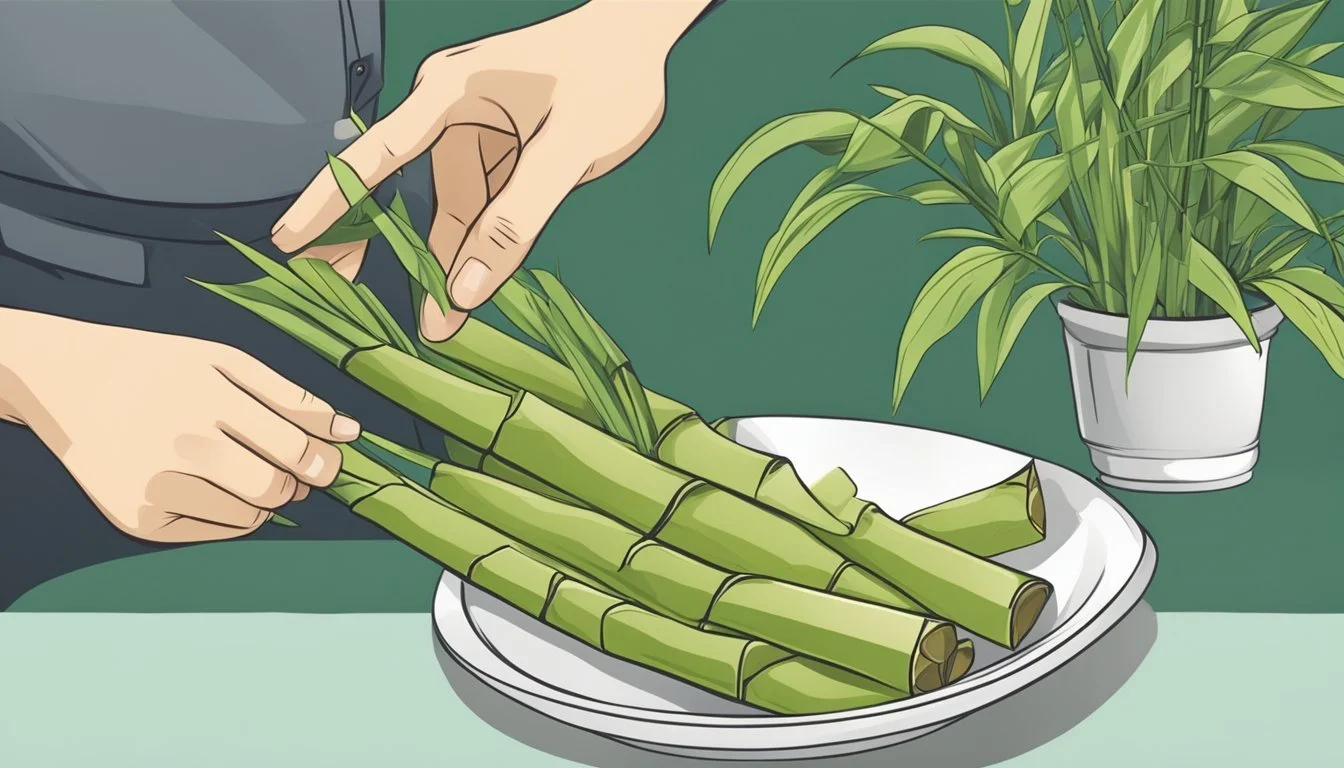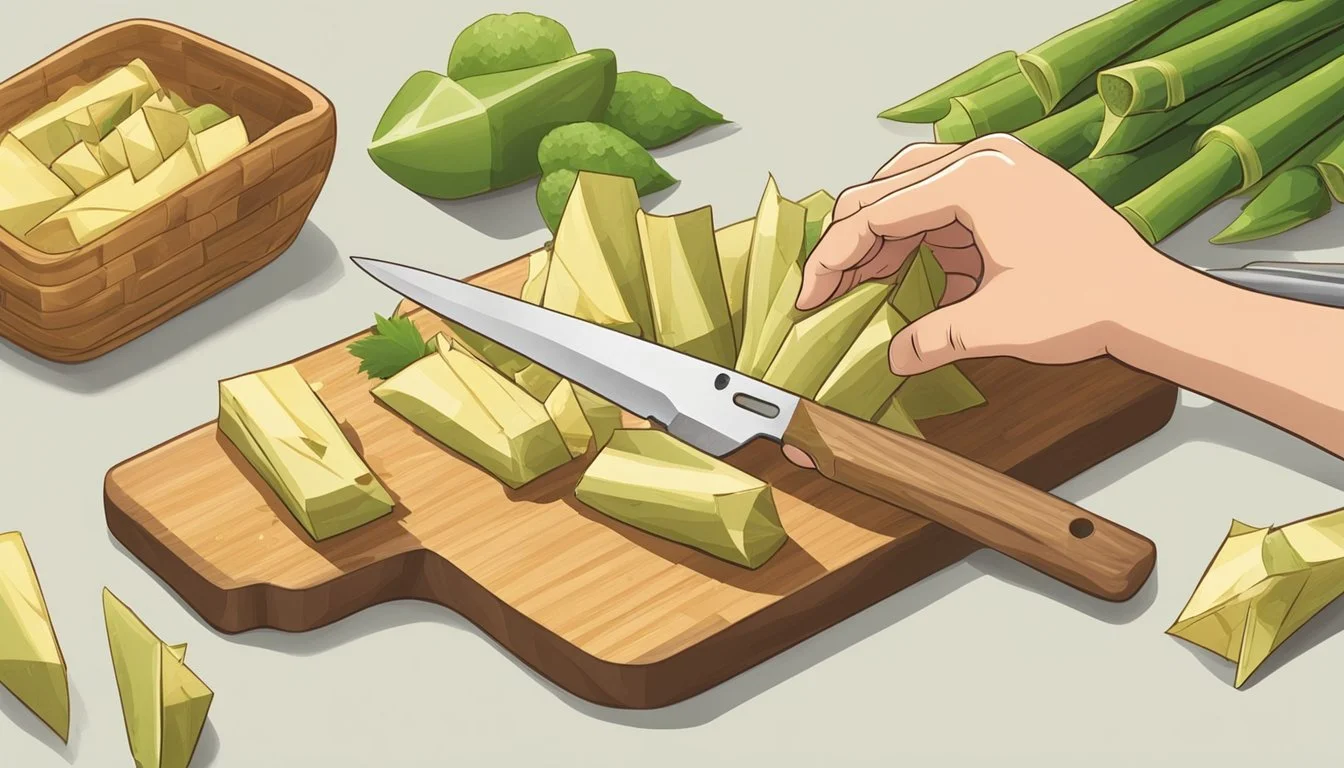How Do You Eat a Bamboo Shoot?
A Guide to Preparing and Enjoying this Asian Delicacy
Bamboo shoots are the edible sprouts of the bamboo plant, commonly found in many Asian cuisines, where they are prized for their crisp texture and subtle, earthy flavor. While some may be familiar with their presence in dishes such as stir-fries or as a component in heartwarming broths, the proper preparation of bamboo shoots is crucial to both their taste and safety for consumption. Raw bamboo shoots contain cyanogenic glycosides, which can release cyanide in the gut if not properly removed through cooking.
To make bamboo shoots edible, a process of thorough cleaning and cooking is important. The shoots first need their tough outer layers removed to expose the tender inner core, which is lighter in color and softer in texture. Boiling is a common method for preparing bamboo shoots for consumption. The shoots are placed in a saucepan, covered with water, and brought to a boil. The initial boil, lasting around 20 minutes, is essential for leaching out the bitter taste and any toxins.
Once the initial boiling is completed, the water is discarded, and the shoots undergo a second round of simmering until tender. This ensures that bamboo shoots can be safely and enjoyably consumed, either on their own or as an ingredient in a broader array of dishes. Whether enjoyed in a salad, paired with meats, or served in a vegetarian dish, properly prepared bamboo shoots offer a versatile and nutritious addition to a meal.
Identifying and Selecting Bamboo Shoots
When it comes to bamboo shoots, the key for consumers is to understand the difference between fresh and canned varieties, and to recognize the various species of bamboo that are edible. Fresh shoots are prized for their tenderness, but they often undergo a process to remove bitterness. Canned varieties are more accessible but may differ in flavor and texture.
Fresh vs Canned Varieties
Fresh Bamboo Shoots:
Availability: More commonly found during springtime when shoots are young and tender.
Preparation: Requires peeling and boiling to remove the hydrocyanic acid that imparts a bitter taste.
Fresh bamboo shoots should appear ivory-colored and feel firm to the touch. They can be consumed raw or cooked once adequately prepared.
Canned Bamboo Shoots:
Convenience: Pre-cooked and ready to use straight out of the can.
Flavor and Texture: Slightly altered from fresh shoots due to the canning process.
It's important to rinse canned bamboo shoots under water to improve their taste before adding them to dishes.
Understanding Bamboo Shoot Varieties
Bamboo species can vary widely, thus affecting the taste and texture of the shoots. For consumption, certain varieties are preferable due to their less bitter taste and more tender flesh. Here are some specifics:
Phyllostachys edulis: Known for producing very large shoots that are commonly used in cooking.
Bambusa oldhamii: Produces tender shoots that are less bitter, favored in many Asian dishes.
Consumers should research or consult experts on local varieties that are good for consumption, as not all bamboo shoots are edible or palatable.
Preparation Techniques
Proper preparation is essential for enjoying the delicate flavor and texture of bamboo shoots. This section guides one through the key steps ensuring that bamboo shoots are ready to be transformed into a culinary delight.
Peeling and Cleaning
One begins by peeling the tough outer layers of the bamboo shoot to reveal the tender core inside. It is recommended to discard the hard, fibrous base along with the pointed tip. After peeling, thorough cleaning is imperative to ensure all dirt is removed. One should rinse the shoots under cold running water, gently scrubbing any residual soil.
Slicing and Cutting
After cleaning, the bamboo shoot should be sliced or cut according to the requirements of the recipe. The shoots can be sliced into thin strips for stir-fries or chopped into chunks for braises. Slicing before boiling can help in evenly cooking the shoots and can also assist in the removal of any potential bitterness.
Cooking and Boiling Bamboo Shoots
Before indulging in the crisp texture and subtle sweetness of bamboo shoots, one must properly cook them to ensure they're safe and enjoyable to eat. Boiling is the initial and crucial step to mitigate any bitterness and remove harmful elements.
Boiling and Blanching
To boil bamboo shoots, one should first peel and cut off any tough or fibrous parts from the base. The shoot should then be placed in a saucepan, covered with water, and brought to a boil. It is recommended to add a pinch of salt to the water to help alleviate any possible bitterness. Boiling should continue for at least 20 minutes. After this, the cook should drain and change the water, continuing to simmer the shoots until they're tender, which usually takes about an hour.
Blanching is a quick method to further refine the shoots' flavor. After the initial boil, one can slice the bamboo shoots and blanch them by submerging them in boiling water for 2-3 minutes. Afterward, they are promptly drained and rinsed with cold water to halt the cooking process.
Storing Pre-Cooked Shoots
Once cooked, bamboo shoots can be stored for later use. Cooked shoots should be allowed to cool completely before transferring them to an airtight container. They should be kept in the refrigerator to maintain freshness. The shelf life of cooked bamboo shoots is typically around one week when stored properly in the refrigerator. Adding a small amount of water to the container can help retain moisture and keep them from drying out.
To extend their usability, one might also freeze the cooked bamboo shoots. They should be sealed in an airtight container or freezer bag to prevent freezer burn. When frozen, bamboo shoots can last up to several months while retaining their quality. Before reusing them, they should be thawed in the refrigerator and reheated properly.
Incorporating Bamboo Shoots into Dishes
Bamboo shoots offer a unique culinary experience, mainly because of their crisp texture and the subtle, slightly sweet flavor they can impart to a dish. They are commonly used across a variety of recipes within Asian cuisines and have found their way into modern and fusion dishes.
Asian Cuisine Applications
In Asian cuisine, bamboo shoots are a staple ingredient revered for their versatility. They are commonly added to stir-fry dishes, bringing a crunchy texture and a capacity to absorb flavors from the seasonings used. Chinese stir-fry recipes often incorporate bamboo shoots alongside ingredients like mushrooms, bell peppers, and a savory sauce based on soy or hoisin.
Japanese recipes may use bamboo shoots in dishes such as soups and rice dishes. One such dish is Chikuzenni, where bamboo shoots are simmered with chicken and vegetables. The shoots are also a key component in miso soup, often paired with tofu and seaweed. Their subtle flavor complements the umami-rich miso without overpowering the soup.
Thai cuisine incorporates bamboo shoots in red or green curries, cooked with coconut milk and a complex blend of herbs and spices.
In Vietnamese food, (What wine goes well with Vietnamese food?) bamboo shoots might be pickled and served as a garnish, adding a tangy note to balance rich flavors.
Modern and Fusion Recipes
Chefs in modern kitchens experiment with bamboo shoots, integrating them into fusion recipes that blend traditional Asian flavors with western techniques. For instance, bamboo shoots can add an unexpected twist to a classic salad, providing a crunchy contrast to soft greens and robust dressings.
Cuisine Type Dish Example Role of Bamboo Shoots Asian-Fusion Bamboo Shoot Risotto Substitute for traditional vegetables Contemporary Roasted Vegetable Medley Textural contrast Western Bamboo Shoot Macaroni and Cheese Adds a nutty, earthy undertone
Through creative applications, bamboo shoots elevate the texture and flavor profile of a wide range of modern dishes, from adding substance to vegetarian plates to enhancing meaty main courses with their distinct but versatile flavor. They pair well with a variety of seasonings, from simple salt and pepper to more complex spice blends, proving to be an adaptable ingredient in the contemporary culinary landscape.
Flavor Enhancements and Pairings
When preparing bamboo shoots, the right condiments and complementary ingredients can elevate the dish, bringing out the natural flavors while adding complexity and depth.
Selecting Condiments
Selecting the appropriate condiments is essential for enhancing the delicate taste of bamboo shoots. Soy sauce and rice vinegar are staples in Asian cuisine, providing umami and a slight tang respectively. Mirin, a sweet rice wine, can add a subtle sweetness, balancing the savory notes. For a touch of warmth, a few spices like ginger or a hint of five-spice can be incorporated. Here is a simple guide to condiment selections:
Soy Sauce: Adds saltiness and depth; great for marinades and dressings.
Rice Vinegar: Offers a mild acidity; perfect for pickling or to brighten up dishes.
Mirin: Contributes a mild sweetness; ideal for glazes
Nutritional Profile and Health Benefits
Bamboo shoots offer a unique combination of nutrients that contribute to various health benefits. They combine a low calorific count with significant fiber content and a rich mix of vitamins and minerals.
Macro and Micronutrients
Bamboo shoots are notable for their low calorie and high fiber content, making them suitable for weight management. Protein is an integral component of bamboo shoots, contributing to muscle maintenance and overall health. In terms of fat, bamboo shoots contain heart-healthy fats, including omega-3 and omega-6 fatty acids.
Micronutrients found in bamboo shoots contribute to overall nutritional balance. These shoots are a good source of essential minerals such as potassium, manganese, copper, calcium, iron, zinc, and phosphorus. Bamboo shoots also boast a range of vitamins, including vitamins B6, E, thiamine (B1), niacin (B3), riboflavin (B2), and traces of selenium.
Nutrient Contribution Protein Supports muscle and body maintenance Fiber Aids in digestive health and can contribute to lower cholesterol levels Vitamins B6 & E Essential for various bodily functions Potassium Vital for maintaining blood pressure Manganese & Copper Important for overall body functions
Dietary Impact of Bamboo Shoots
Bamboo shoots can have a positive effect on one's diet, particularly regarding digestive and gut health due to their high fiber content. They may support weight loss efforts as they are low in calories yet make one feel full. Additionally, certain components in bamboo shoots have anti-inflammatory properties, which can further contribute to health by potentially reducing the risk of certain diseases.
The nutrient-dense profile of bamboo shoots means they can contribute to lowering cholesterol levels and maintaining healthy blood pressure—factors which are essential to cardiovascular health. They also contain a balance of essential nutrients that can boost one's overall nutrient intake when included as part of a varied diet.
Safety and Precautions
When consuming bamboo shoots, safety is paramount due to the presence of natural toxins. Proper preparation is crucial to neutralize these compounds and ensure the shoots are safe and enjoyable to eat.
Addressing Toxins
Bamboo shoots contain cyanide, a toxic compound that can be harmful if consumed in large quantities. However, the shoots are safe to consume once they are properly prepared. The cyanide content is higher in raw bamboo shoots, making them poisonous if ingested without adequate processing. To address this issue, one must cook bamboo shoots thoroughly to break down these toxins.
Initial Step:
Peel the shoots to remove the tough outer layer.
Rinse the shoots thoroughly to remove any debris or residual toxins.
Cooking Method:
Boil the bamboo shoots for at least 20 minutes.
Discard the water and rinse the shoots again.
For complete safety, it's recommended to repeat the boiling process with fresh water.
After these steps, the level of toxins in the bamboo shoots is significantly reduced, making them safe for consumption. It's also important to note that proper preparation not only enhances safety but might also increase the bioavailability of beneficial nutrients, such as vitamin B.
Preparation to Reduce Bitterness
The natural bitterness in bamboo shoots is often due to the presence of cyanide-related compounds. To ensure a more palatable experience, the following preparation steps are recommended:
Boiling:
Place the bamboo shoots in a saucepan and cover with water.
Bring to a boil and cook for 20 minutes.
Change the water and simmer until the shoots are tender.
Blanching:
Slice the bamboo shoots into desired sizes.
Boil water in a pot and blanch the sliced shoots for 2-3 minutes.
Drain and rinse with cold water to halt the cooking process.
These steps help to remove the bitter taste, making the bamboo shoots more enjoyable while ensuring that they are safe to eat.
Storing Bamboo Shoots
Proper storage is essential for maintaining the quality and freshness of bamboo shoots. Whether one opts for the preservation of tender bamboo shoots in their fresh state or extends their shelf life through canning and freezing, knowing the right storage methods is crucial.
Fresh Storage Tips
Once harvested, fresh bamboo shoots should be kept moist and cool to retain their tenderness. They can be wrapped in a damp cloth and placed inside a plastic bag before storing in the refrigerator. This method can keep the shoots fresh for about two weeks. It's also important to ensure that the environment inside the refrigerator is not overly dry, as this may cause the shoots to become tough.
Preserving Canned Shoots
Canned bamboo shoots should be transferred to a non-metallic, airtight container after opening if they are not used immediately. One should store these in the refrigerator, where they will remain good for up to one week. If one wishes to store canned bamboo shoots for a longer period, freezing is an effective method. After draining the brine, the shoots can be packed into freezer bags, with as much air removed as possible, and stored in the freezer for several months.
Recipes and Serving Suggestions
Bamboo shoots are a versatile ingredient that can elevate both the texture and flavor of a variety of dishes, from the crunch in stir-fries to the mild sweetness in soups.
Stir-Fries and Salads
Stir-fries incorporating bamboo shoots bring a delightful crunch and a subtle nuttiness to each bite. A classic stir-fry might include thinly sliced bamboo shoots along with carrots, long beans, and kikurage (wood ear mushrooms), all seasoned with soy sauce, ginger, and garlic. Here is a simple way to integrate bamboo shoots into stir-fries:
Heat a wok and add a tablespoon of oil, like peanut or olive.
Add bamboo shoots and other vegetables such as carrots and long beans.
Stir-fry for a few minutes until the vegetables are tender but still crisp.
Season with soy sauce, ginger, and garlic for flavor.
For salads, bamboo shoots add a distinctive texture that complements softer ingredients. They pair well with leafy greens, adding substance to lighter dishes. Consider a salad with a blend of bamboo shoots, spinach, and mixed greens, tossed with a sesame dressing for an earthy taste.
Stews and Soups
Stews benefit from the addition of bamboo shoots by absorbing the flavors of the broth while maintaining their texture. They work particularly well in slow-cooked dishes where they contribute a subtle sweetness that complements richer ingredients like pork or beef. An example of a stew preparation might involve:
Adding sliced bamboo shoots to the stew pot along with meats and hardy vegetables.
Letting the mix simmer in a seasoned broth until all ingredients are tender.
In the realm of soups, bamboo shoots are a quintessential element, especially in Asian cuisine. The shoots infuse the soup with a mild flavor and a pleasing texture contrast. One might make a classic chicken and corn soup, including bamboo shoots for a satisfying crunch.
Begin with a base of chicken stock, adding bamboo shoots and corn kernels.
Enhance the flavor with ingredients like a dash of sesame oil and some freshly chopped green onions before serving.
Whichever dish they are added to, bamboo shoots should be thoroughly boiled prior to incorporating them into recipes to ensure they are tender and free of bitterness.
Cultural Context
Bamboo shoots have a significant role in the culinary heritage of many Asian countries, used extensively in regional dishes for their unique texture and flavor. They are becoming more integrated into global cuisine, demonstrating versatility and adaptability to various culinary practices.
Bamboo Shoots in Asian Gastronomy
In Japan, bamboo shoots, or takenoko, are a prized ingredient, especially in springtime dishes. They are commonly featured in traditional preparations like takenoko gohan (bamboo shoot rice) and are often found in ramen and other soups. They impart a tender yet crisp texture that is cherished in Japanese cuisine.
China equally values bamboo shoots, integrating them into a multitude of dishes across its diverse culinary regions. Notably used in stir-fries, soups, and as fillers in dumplings, bamboo shoots contribute an essential earthy flavor. They are typically boiled before use to eliminate bitterness. In Asian cuisine, the shoots are also pickled, braised, or used in curries and salads, showcasing their wide-ranging application.
Global Use and Adaptations
Their adoption into global cuisine is a testament to the bamboo shoot's versatility. Chefs around the world have innovated with bamboo shoots, incorporating them into vegetarian dishes (What wine goes well with vegetarian dishes?), meat-based meals, and balanced sides. They provide a gluten-free alternative to other thickening agents and add fiber to the diet.
Global Use of Bamboo Shoots:
Vegetarian Cuisine: Substituted for other veggies for texture.
Meat Dishes: Paired with meats for a contrasting bite.
Fusion Dishes: Integrated into traditional dishes from various cuisines for an Asian twist.








